A sightseer’s guide to the history of Ortigia, Sicily
A guest post by Lisa Franceschini.
The history of Ortigia – sometimes spelled Ortygia – is very ancient. The islet, the oldest part of Siracusa in eastern Sicily, has been inhabited since at least the 14th century BC. As you stroll through the alleys and piazzas of Ortigia, you will come across several landmarks that testify to the richness of its history. Let’s look at the most crucial events in Ortigia’s history. As we go, we’ll see the historical traces in Ortigia’s main sights in chronological order.
Disclosure: This article contains affiliate links. If you make a purchase through one of these links, I (Rachel) will receive a small commission. This will not affect your price.
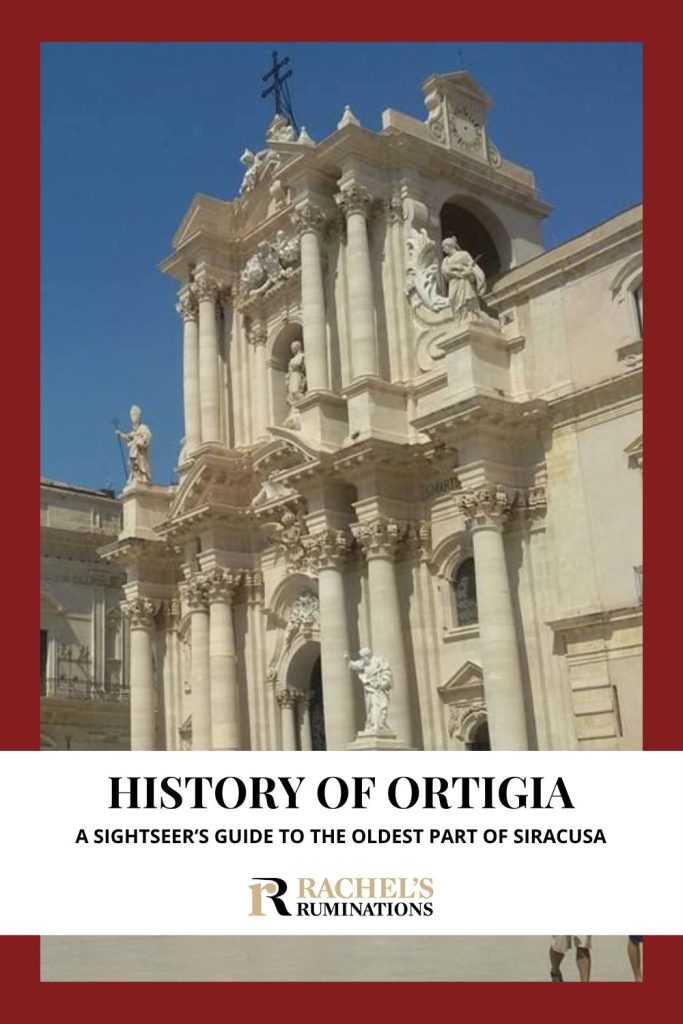
Ortigia is Siracusa’s most ancient neighborhood. According to finds from the protohistoric period unearthed in the area, Ortigia island was inhabited from at least the 14th century B.C., the Bronze Age. The earliest documents mentioning Ortigia, on the other hand, date from the time of the Greek conquest.
The Ancient Greeks in Ortigia
Greek colonists from Corinth led by the leader Archia founded the city of Siracusa on the islet of Ortigia in 734 BC.
On the origin of the name Siracusa, there is only speculation. Perhaps it derives from a river that flowed near Ortigia at the time, or perhaps from the Phoenician language (The Phoenician words sur and acco mean “hot rock”). On the other hand, the name Ortigia means “quail” in Greek. The Greeks called the new city “Syracoussai.” Contemporary Syracusans call it Sarrahoosah.
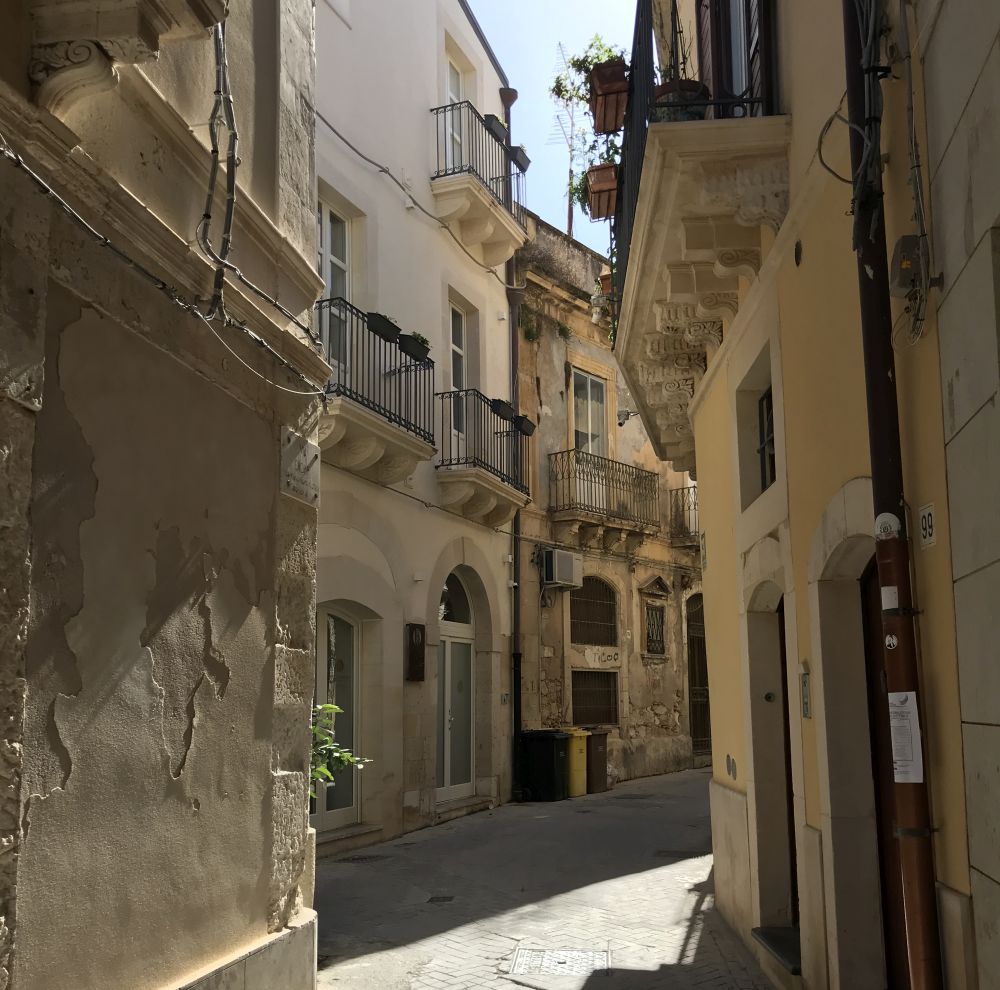
Siracusa quickly became very wealthy; it had two ports and a river serving it. An aristocracy of Greek landowners stationed in Ortigia ruled the people, who worked in the fields. The descendants of the indigenous people, on the other hand, didn’t have any political rights.
1. The Cathedral of Syracuse and the Temple of Athena
Temples dedicated to the deities of Greek mythology – Zeus, Apollus, and Athena – appeared in Ortigia. The baroque Syracuse Cathedral, which you can visit today in the heart of Ortigia on the Piazza Duomo, stands on the remains of the Greek temple of Athena. On one of the sides of the cathedral, you can admire the impressive Greek columns incorporated into the structure.
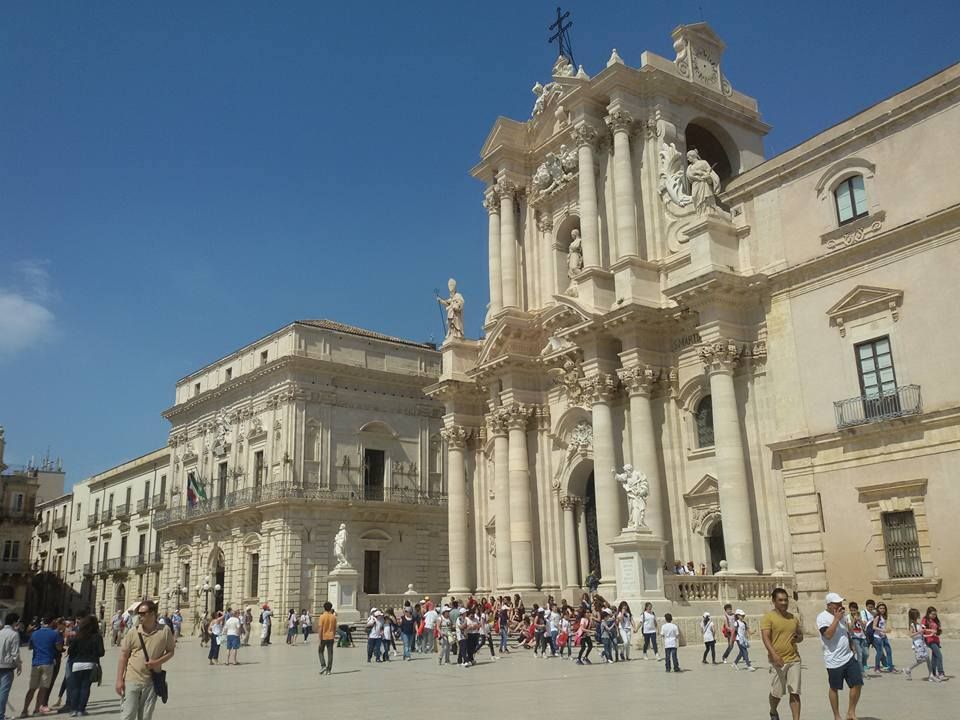
Ortigia’s Piazza del Duomo, by the way, is a great place to sit on a park bench, relax and enjoy a snack while you do some people-watching. You’ll also see the late-baroque Archbishop’s Palace, though inside its courtyard is an earlier chapel from the Swabian period (around 1200 AD) that was part of the original palace on this site. The baroque Church of Santa Lucia alla Badia is located on this piazza as well. Very nearby the church is the 18th-century rococo Palazzo Borgia del Casale, also worth seeing.
Planning to rent a car to drive around Sicily? Compare rental car prices here.
2. The Temple of Apollo
The Temple of Apollo arose near what is now Pancali Square (Piazza Emanuele Pancali). It is the oldest Doric-style temple in Sicily and perhaps of all the Greek colonies. Today, you can still admire its base and the remains of the 46 columns, looking out from the street level. Nearby is the Old Market of Ortigia, a great place to wander the stalls in search of provisions for lunch.
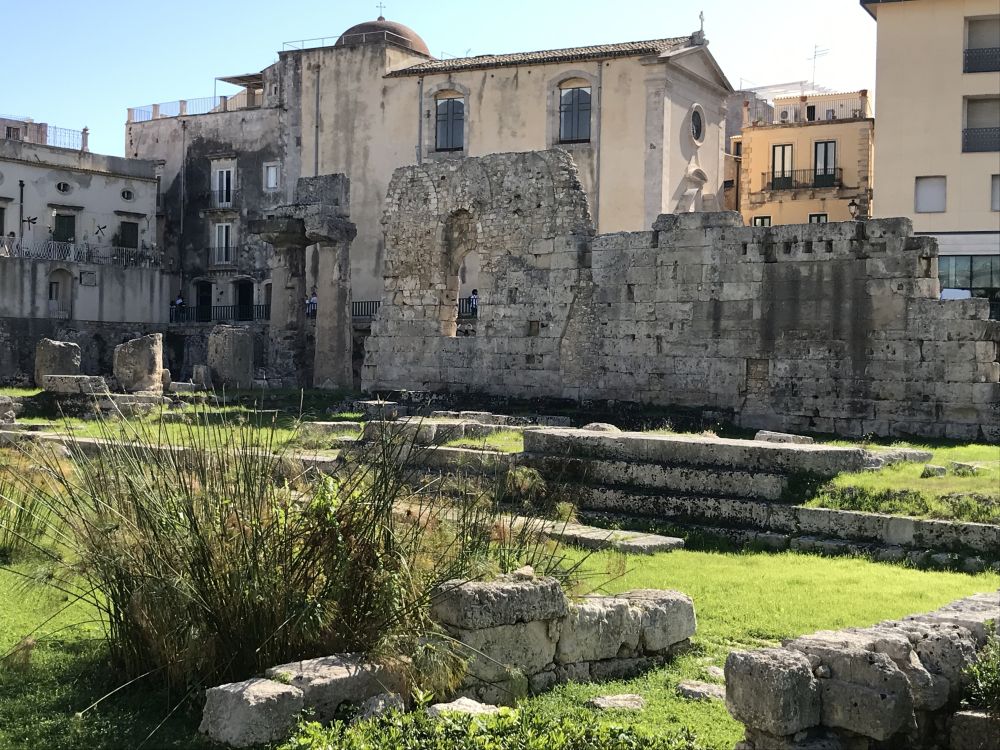
3. The Arethusa Fountain (Fonte Aretusa)
It is to the Greek era that the legend of the Arethusa Spring traces back, one of the most fascinating Italian legends. On the island of Ortigia, just a few meters from the sea and the great port of Siracusa, is a charming and very special place, the Arethusa Spring. It is a freshwater spring and the only place in Europe (along with the Ciane River, also in Siracusa) where papyrus plants grow naturally. The water from the spring collects in a pool where, in addition to papyruses, fish and ducks live.
Visiting the Arethusa Fountain in Ortigia is considered auspicious for young couples. Let’s see why:
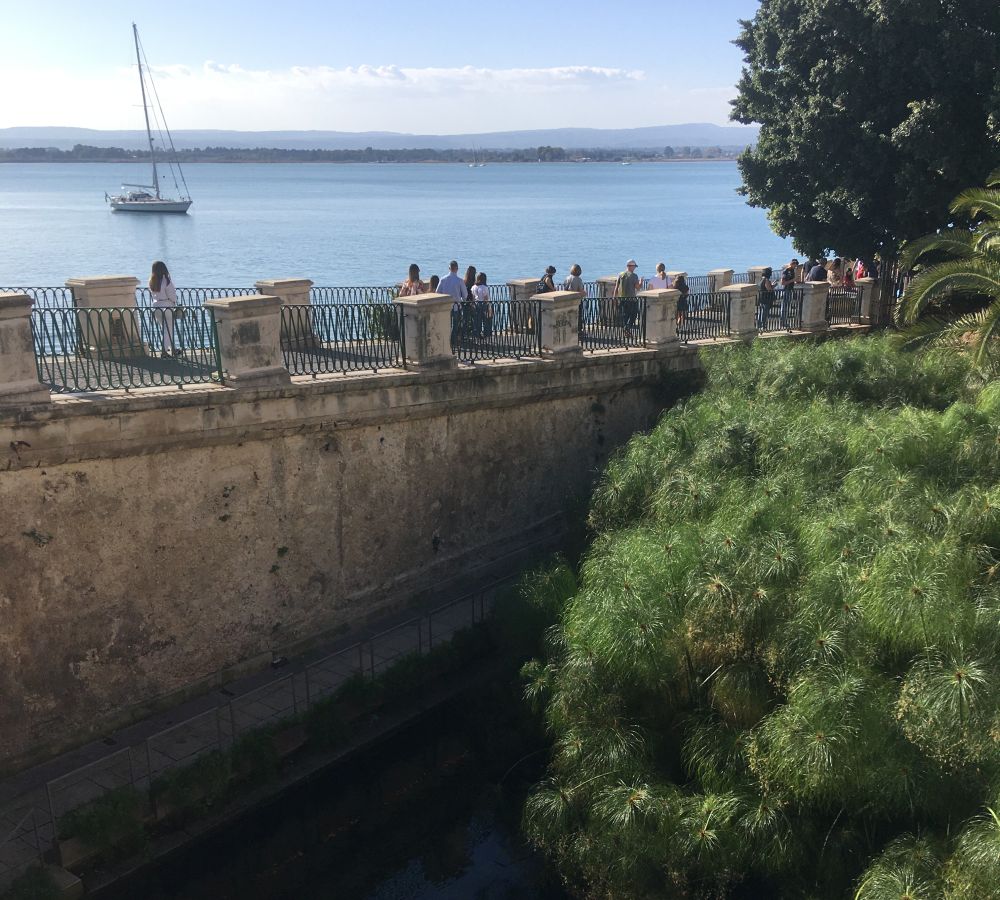
The Myth of Arethusa
The protagonist of the legend is Arethusa, a nymph in the retinue of the goddess Artemis (or Diana), the goddess of the hunt. Arethusa had gone out hunting with the goddess and felt a great heat, so she approached the river Alphaeus (in Greece, in the Peloponnese.). She took off her clothes and plunged into the water.
The river’s god saw her and fell in love with her. The river water rippled as the god took on human form and showed himself to Arethusa as a young man with eager eyes. Arethusa saw him and was frightened. She came out of the water and began to run far away, but Alphaeus ran after her. Arethusa’s fear was so great that the goddess Artemis decided to send her far away, right to Ortigia, making her a freshwater spring near the seashore.
(See the comments below for one reader’s different version of this tale!)
You might want to save your visit to Arethusa fountain until close to sunset. Either settle in at a restaurant nearby or walk out on the nearby jetty to admire a gorgeous sunset.
A neo-classical fountain, the Fontana di Diana, on the Piazza Archimede is based on the myth of Arethusa.
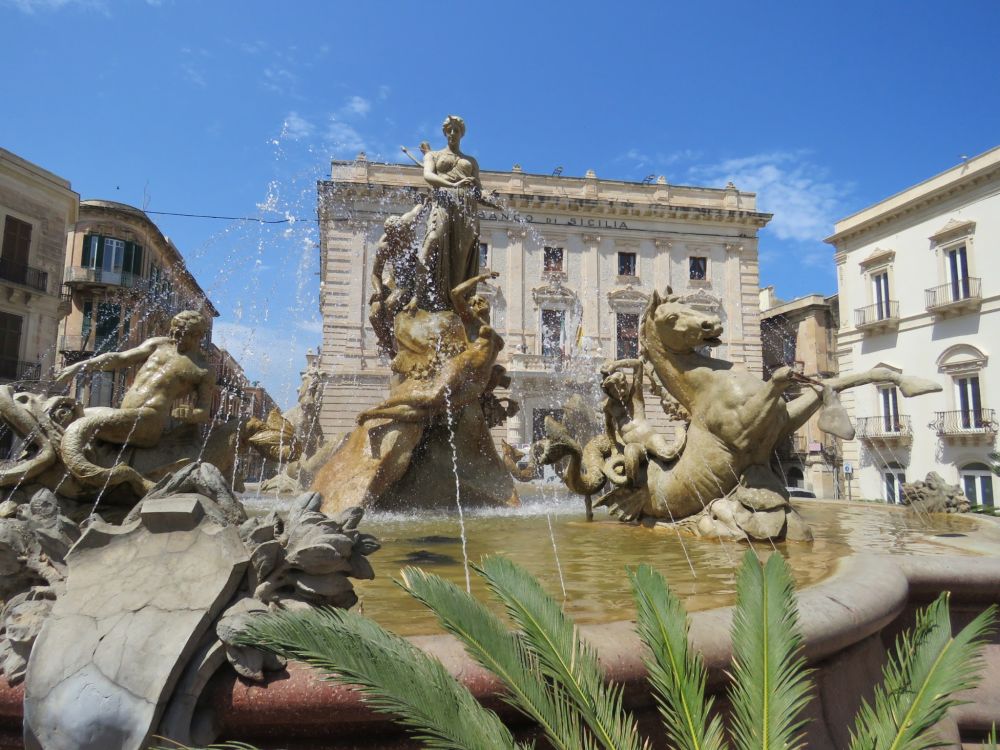
The Period of the Tyrants
This period in the history of Ortigia – the 5th to 3rd centuries BC – saw a succession of wars and tyrannies. The occasion was provided by a popular uprising in the early 5th century BC that unhinged political power. Siracusan nobles’ families took refuge in the nearby city of Gela and, from there, organized the retaking of Siracusa. Led by the leader Gelon, an army recaptured Siracusa and assumed full powers, but it did not stop there. Joining forces with the tyrant of Agrigento, Theron, Gelon defeated the Carthaginians at Imera in 480 BC.
After Gelon’s death, his brother Hieron succeeded him. He fought and defeated the Etruscans at Cumae (474 BC), ensuring Siracusa’s control of the routes in the southern Tyrrhenian Sea. Wars also continued with the successors of the first two tyrants.
Take a walking tour of Ortigia.
4. Neapolis Archaeological Park
Dionysius, who came to power in 465 BC, deserves a mention. His military prowess and successes in the Punic Wars and against the League of the Italian hinterland led the polis of Syracuse to subjugate all of Sicily. Dionysius was also a man of culture as well as a ruthless tyrant. The Greek Theater of Syracuse, located just outside Ortigia on the mainland, dates from the time of his rule over the polis.
Today you can visit the Neapolis Archaeological Park (Parco Archeologico della Neapolis) and discover, in addition to the theater, the Paradise Quarry, also known as the Ear of Dionysius. It is said that in this quarry, with extraordinary acoustic properties, the tyrant locked up prisoners of war. Approaching the entrance to the quarry, Dionysius could hear all their secrets, even if whispered, because the quarry amplifies sounds 16 times.
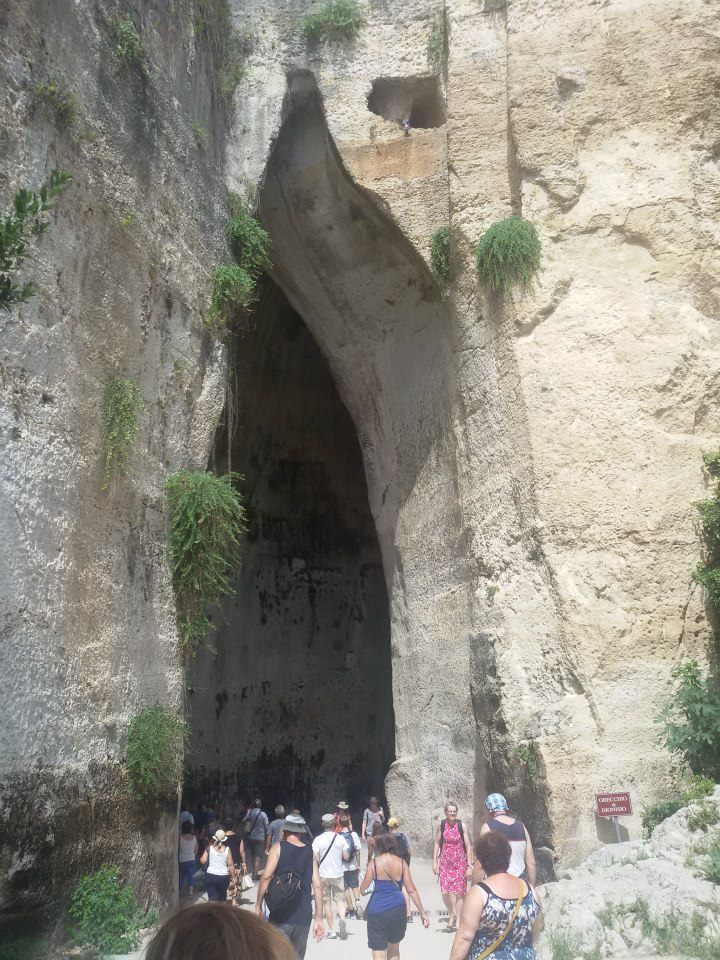
After the rule of Dionysius, there was a war with Athens that Siracusa won, as well as other struggles with the Carthaginians and other cities of Magna Graecia, until the Roman conquest of Siracusa.
Will you be passing through Rome on your way to Sicily? Read this before you go!
The Romans in Siracusa
A key event in the history of Ortigia happened in 212 BC when Roman soldiers, led by Marcus Claudius Marcellus, conquered Siracusa after a long siege. The famous mathematician and inventor Archimedes, a Siracusan, also lost his life then. To learn more about Archimedes, head to the Museo Archimede e Leonardo, which has interactive exhibits about the inventions of Archimedes and Leonardo da Vinci too.
Soon after conquering Siracusa, the Romans conquered all of Sicily, which became a Roman province with its capital in Siracusa itself. The well-known Roman orator Cicero called Siracusa “the most beautiful city in Magna Graecia.” Siracusa was also home to Scipio Africanus, who set out from there to defeat the Carthaginian Hannibal for the Romans. Roman rule lasted for several centuries until the fall of the Western Roman Empire in the 5th century AD.
If you’re going to be exploring Ortigia, you should certainly stay in this oldest part of Siracusa. There are plenty of accommodations available; use the map below to help you choose:
History of Ortigia and Siracusa after the Romans
What followed Roman rule was a series of conquests over many centuries. Vandals and Goths occupied the city, and then the Byzantines conquered it by the 6th century AD. In the 9th century came the Arab Saracens, and in the 11th century the Normans (from Northern France). Siracusa then came under Swabian (from Germany) and then Aragonese (Spain) rule.
Siracusa, in the following centuries, became a crossroads of peoples and cultural influences, given this succession of conquests. We can still discern these various influences today in the city’s architecture and its museums.
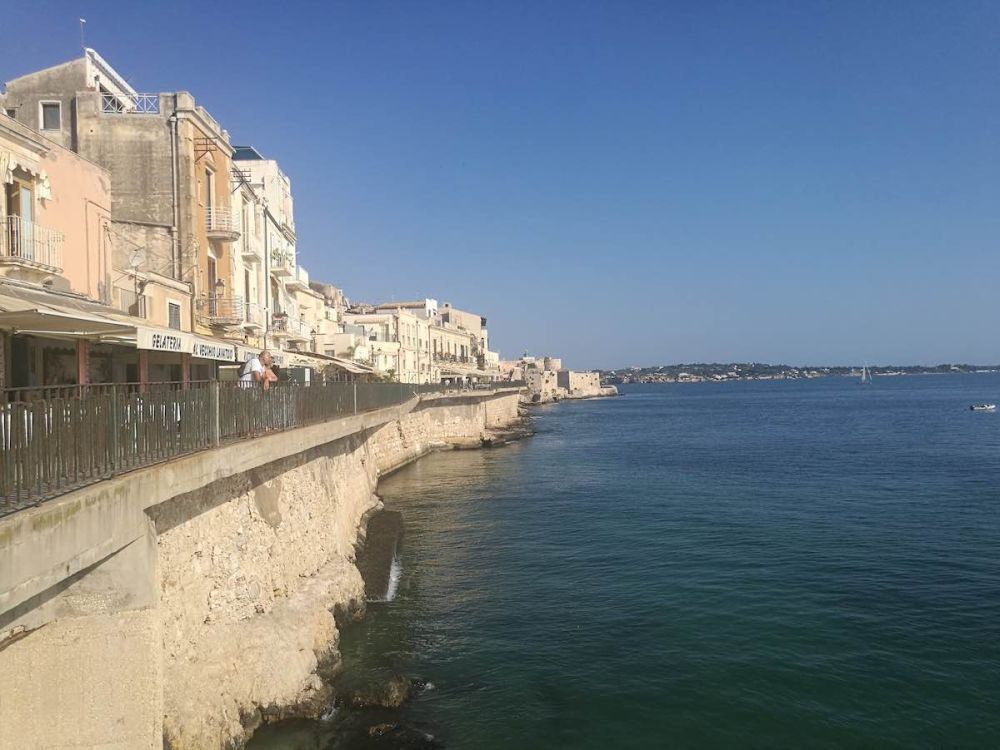
There was also a Jewish population in Siracusa: only about 2000 people at its height. In 1492 they were forced to leave (or convert to Catholicism or die) by the Spanish (Aragonese) who ruled at the time.
While the Jewish Quarter still has the same street layout, there are only a few reminders of this population. A Byzantine-era mikveh (ritual bath), dating to the 6th century and the oldest Jewish ritual bath in Europe, was rediscovered in 1989 under a hotel, the Residence Hotel Alla Giudecca, in the middle of the old Jewish Quarter. Short guided tours are available every day through the hotel. Four tombstones from the medieval Jewish cemetery are viewable at the Regional Gallery at Palazzo Bellomo. Palazzo Bellomo dates from the Swabian period, and the Regional Gallery houses artworks ranging from the medieval period to the 18th century.
5. Maniace Castle
Maniace Castle, a fortress intended to protect the port of Ortigia, dates to the time of the Normans and Swabians. In the 15th century, King Martin I of Sicily made it a free port. The last foreign conquest was by Charles III of Bourbon in 1735. In 1860, Garibaldi’s militia defeated the Bourbons. The city was annexed to the Kingdom of Italy in 1861 and was part of it until the founding of the Italian Republic in 1946.
Siracusa in contemporary times
In 2005, Siracusa (including Ortigia) was declared a UNESCO World Heritage site, in combination with the Necropolis of Pantalica, about 40 kilometers away. Today, the city thrives mainly from tourism and commerce.
Even if you only have one day to spare, devote it to walking through the narrow streets of Ortigia, which still faithfully traces the structure of the ancient Greek city. Besides seeing these particular historical sites, wandering is one of the best things to do in Ortigia, admiring the elegant baroque architecture of the houses, palaces, churches, and piazzas.
Alternatively, take a day trip to Siracusa from Catania, Taormina, or Palermo. Better yet, take a walking tour in Ortigia.
If you’d rather wander at your own speed, you can see on the map below that most of the main sights mentioned here form more or less a north-south line, with a couple of detours.
Suggested tour route
Walking in the chronological order of the history of Ortigia as described above would not be very efficient. Instead, use the order below:
Start with Neapolis Archeological Park (not in Ortigia).
Cross the bridge called Ponte Umberto 1 to reach Piazza Pancali and the Temple of Apollo. This is a half-hour walk or a ten-minute taxi ride from the archeological park. The rest of the sights, in order, are:
- The Archimede and Leonardo da Vinci Museum
- The Diana Fountain
- Syracuse Cathedral
- The Archbishop’s Palace
- The Church of Santa Lucia alla Badia
- Palazzo Borgia del Casale
- From here you need to cross the island (less than 10 minutes’ walk) if you want to see the mikveh at Residence Hotel Alla Giudecca.
- Cross the island back again to Regional Gallery at Palazzo Bellomo.
- Next, see the Arethusa Spring.
- Castello Maniace is on the very tip of the island. The road between Arethusa Spring and the castle along the waterfront, the Lungomare Alfeo, is very pleasant and has lots of restaurants to choose from.
If you’re staying in Siracusa rather than Ortigia, you could see these in reverse order: take a taxi to the bottom of the island, then work your way back. It’s about a 15-minute drive from the Neapolis Archaeological Park to the closest you can drive to Castello Maniace.
Talking about the history of Siracusa is equivalent to talking about the history of Ortigia, which is its oldest neighborhood. On the islet of Ortigia, joined to the mainland by two bridges, you will find many traces of Siracusa’s past. The Temple of Apollo, the Fountain of Arethusa, Siracusa Cathedral, and Maniace Castle are just some of the sites of historical interest that you can visit.
Have you been to Ortigia? Do you have any tips to share? Add a comment below!
My travel recommendations
Planning travel
- Skyscanner is where I always start my flight searches.
- Booking.com is the company I use most for finding accommodations. If you prefer, Expedia offers more or less the same.
- Discover Cars offers an easy way to compare prices from all of the major car-rental companies in one place.
- Use Viator or GetYourGuide to find walking tours, day tours, airport pickups, city cards, tickets and whatever else you need at your destination.
- Bookmundi is great when you’re looking for a longer tour of a few days to a few weeks, private or with a group, pretty much anywhere in the world. Lots of different tour companies list their tours here, so you can comparison shop.
- GetTransfer is the place to book your airport-to-hotel transfers (and vice-versa). It’s so reassuring to have this all set up and paid for ahead of time, rather than having to make decisions after a long, tiring flight!
- Buy a GoCity Pass when you’re planning to do a lot of sightseeing on a city trip. It can save you a lot on admissions to museums and other attractions in big cities like New York and Amsterdam.
- Ferryhopper is a convenient way to book ferries ahead of time. They cover ferry bookings in 33 different countries at last count.
Other travel-related items
- It’s really awkward to have to rely on WIFI when you travel overseas. I’ve tried several e-sim cards, and GigSky’s e-sim was the one that was easiest to activate and use. You buy it through their app and activate it when you need it. Use the code RACHEL10 to get a 10% discount!
- Another option I just recently tried for the first time is a portable wifi modem by WifiCandy. It supports up to 8 devices and you just carry it along in your pocket or bag! If you’re traveling with a family or group, it might end up cheaper to use than an e-sim. Use the code RACHELSRUMINATIONS for a 10% discount.
- I’m a fan of SCOTTeVEST’s jackets and vests because when I wear one, I don’t have to carry a handbag. I feel like all my stuff is safer when I travel because it’s in inside pockets close to my body.
- I use ExpressVPN on my phone and laptop when I travel. It keeps me safe from hackers when I use public or hotel wifi.




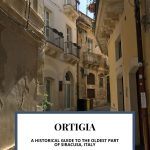
Dear Rachel,
I was actually looking for a reinterpretation of the Aretusa myth. Although the traditional telling is romantic, a post #MeToo reinterpretation indicates that Alpheus’ attentions were unwanted. He pursued her and ‘took’ her unwillingly. Ergo, she is stuck into eternity because Aretusa described Alpheus as a man, not knowing he was divine. Sadly, Artemis didn’t ask enough questions or take a look at the young man herself, thereby condemning her favourite nymph to repeated sexual violations. I know this isn’t what people want to hear, but surely, without being as graphic as I have been, someone could at least suggest that it isn’t a love story, but a stalker story. It might not be such a good idea for a woman to visit the fountain for romantic good luck. It’s like saying that Othello is a love story.
Just sharing my thoughts as a former prosecutor.
I didn’t write this article – it’s a guest post – but even as it stands it’s pretty stalkerish that she has to run away from Alpheus. An all-too-familiar story! Thanks for commenting!